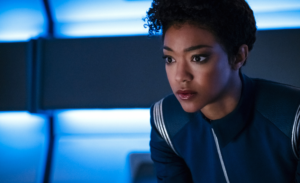
Star Trek: Discovery – Season 1
Starring: Sonequa Martin-Green, Doug Jones, Shazad Latif, Anthony Rapp, Mary Wiseman, Jason Isaacs
Directed by: Various
Written by: Various
Created by: Bryan Fuller & Alex Kurtzman
Based on: Star Trek by Gene Roddenberry
Controversy has never been an alien concept to the Star Trek franchise, but perhaps no other offering has been so laden down with it than Discovery. Ever since its announcement and all through the first season, the fanbase has been torn apart by production woes, design choices, and polarizing executions.
Announced in 2015, Discovery was set to be different. A different look that hearkened back to both the original series as well as the J.J. Abrams movies. A different expression on Star Trek’s most iconic foe. Different personal stories that revolved around flawed characters. Even a different mode of broadcast that focused (at least in the U.S.) on an online service.
Spoilery stuff ahead. Consider yourself warned.
 Discovery‘s story revolved around Michael Burnham (Sonequa Martin-Green). While she starts the series as a First Officer on the USS Shenzhou, most of the series has her set as a rankless Science Specialist aboard the Discovery after instigating a war between the Federation and a fractured Klingon Empire. Her upbringing as Sarek’s adopted daughter (and therefore Spock’s adopted sister) informs her character as analytical and calm. Her humanity creates many opportunities for her emotions and instincts to fully play across her. Even under the strain of some ill-informed and sometimes even racist/misogynist backlash from vocal parts of the community, her character and performance gave Discovery immense humanity and power throughout its run.
Discovery‘s story revolved around Michael Burnham (Sonequa Martin-Green). While she starts the series as a First Officer on the USS Shenzhou, most of the series has her set as a rankless Science Specialist aboard the Discovery after instigating a war between the Federation and a fractured Klingon Empire. Her upbringing as Sarek’s adopted daughter (and therefore Spock’s adopted sister) informs her character as analytical and calm. Her humanity creates many opportunities for her emotions and instincts to fully play across her. Even under the strain of some ill-informed and sometimes even racist/misogynist backlash from vocal parts of the community, her character and performance gave Discovery immense humanity and power throughout its run.
Discovery’s crew is filled with interesting characters expertly brought to life. Captain Gabriel Lorka (Jason Issacs) was a unique captain in Trek history. Secretive, manipulative and cunning. The viewer was never quite sure for the majority of the season as to whether or not he was a villain or just an “at-any-cost” wartime commander. Only later did we understand his true motivations. That was only after he was so close to his goal that he could touch it.
Saru (Doug Jones) gave us a Kelpien Commander with a long and troubled history with Burnham. His race’s ability to sense “the coming of death” with tendrils sprouting from the back of his head did come off as a bit too obvious of a visual queue for the audience that things were about to hit the fan. Saru’s drive to be the voice of reason by studying and emulating the great captains of Starfleet history was a refreshing “fake-it-until-you-make-it” take on a leadership role. Shazad Latif gave us two critical performances; one as screw-loose badass/Burham love-interest Lt. Ash Tyler and the other as albino Klingon Jesus allegory Voq. It would have been so easy to underutilize either character. However, Latif brought sizable energy to both characters, even after they became the same person.
 Rounding out the cast was Paul Stamets (Anthony Rapp) as eccentric engineer and husband to Dr. Hugh Culber (Wilson Cruz). Cadet Sylvia Tilly (Mary Wiseman) who offered up a bright and cheery heart that wavered but never broke. L’Rell (Mary Chieffo) as Voq’s devout acolyte. Michelle Yeoh brings both an intense and nuanced performance as both doting Captain and mirror universe Emperor Phillipa Georgiou. This cast was as far from Roddenberry’s conflict-free humanity as we have ever seen in a Trek show before. It was all the better for it. Trek has always been a window into the tones and conflicts of today’s world (in case you didn’t know, Klingons in TOS were supposed to be Russians and people were pissed about an interracial kiss on TV back then. Go figure), and Discovery upholds that tradition well.
Rounding out the cast was Paul Stamets (Anthony Rapp) as eccentric engineer and husband to Dr. Hugh Culber (Wilson Cruz). Cadet Sylvia Tilly (Mary Wiseman) who offered up a bright and cheery heart that wavered but never broke. L’Rell (Mary Chieffo) as Voq’s devout acolyte. Michelle Yeoh brings both an intense and nuanced performance as both doting Captain and mirror universe Emperor Phillipa Georgiou. This cast was as far from Roddenberry’s conflict-free humanity as we have ever seen in a Trek show before. It was all the better for it. Trek has always been a window into the tones and conflicts of today’s world (in case you didn’t know, Klingons in TOS were supposed to be Russians and people were pissed about an interracial kiss on TV back then. Go figure), and Discovery upholds that tradition well.
The Klingons were themselves a huge point of division among the community but mostly around design philosophy. While moving away from an allegory for a political adversary and now more of an ideological/religious one, some found the amplified costume design and tweaked vocalizations annoying, while others found the changes refreshing and uniquely authentic. Indiewire did a great look at how these changes came to life. The “new” Klingons best represent Discovery’s take on an updated Trek. Iteration of cultural vehicles such as Star Trek is paramount to keep it as a cultural vehicle. This is not 1966, 1987, 1993, 1995 or even 2001. The world has changed drastically. Trek HAD to change with it. We didn’t need a homage, and homages rarely (if ever) make good science fiction.
Visually, Discovery found itself a significantly darker tone than previous Treks. Also using a lot of updated design language we’ve come to expect from the J.J. Abrams movies. Sleek lines and holographic displays met with gunmetal surfaces and muted celestial body lighting, while Klingon ships dropped the greasy smokey look for a far more ceremonial, open and vertically tiered design. The Discovery itself went back to the ideology of “if a child can’t draw it, it’s not iconic enough.”
At certain angles, Discovery was basically the Starfleet logo with a saucer section added. Klingon ships doubled down on the aggressive ceremonial concept, with one plot-critical ship being literally covered with the sarcophagi of fallen Klingon warriors, and others looking like flying bladed torture implements. If you were looking for something fresh yet classic, this was it. It was also at times in the first half of the season difficult to grasp the design language if you were already steeped in decades of previous Treks.
 The costume design was by far the most unique. Starfleet uniforms were blue with metallic accents across the board, doing away with the tradition of signifying the type of job you did with a specific colour uniform. This time, position and rank were indicated primarily with symbols and pips on and around the Starfleet badge itself. Overall, it was a very utilitarian and somewhat sporty look for a Starfleet uniform. The Klingons, on the other hand, didn’t have uniforms and instead continued the tribalistic look on to themselves with many outfits made to look like sharp metallic bone meets samurai armour.
The costume design was by far the most unique. Starfleet uniforms were blue with metallic accents across the board, doing away with the tradition of signifying the type of job you did with a specific colour uniform. This time, position and rank were indicated primarily with symbols and pips on and around the Starfleet badge itself. Overall, it was a very utilitarian and somewhat sporty look for a Starfleet uniform. The Klingons, on the other hand, didn’t have uniforms and instead continued the tribalistic look on to themselves with many outfits made to look like sharp metallic bone meets samurai armour.
As the mechanical design found itself further away from Trek stereotypes, the main title sequence was a pure and wide-eyed homage to the exploratory spirit of Starfleet. Transparent designs made to look like they were inked by Leonardo DaVinci. Moved and operated to the understated symphonic melody that borrows heavily from both the original Trek themes as well as the growing movements of the Abrams movie soundtracks.
Let’s talk about the story and execution. While the Spore Drive was a blatant MacGuffin (that I personally hope is absent from the next season in 2019), it was an effective MacGuffin all told. Acting as not just a piece of Trek tech that physically moved the crew around from plot point to plot point, but also proved as a suitable point of tension from episode to episode. It also put Discovery at the centre of the war that Burnham started, being the only ship with the drive.
At the same time, it refrained from being cripplingly all-encompassing as other MacGuffins tend to be. Discovery spent the majority of its time as a war story driven by personal strife, while a number of episodes spent in the mirror universe shifted things away for an enjoyable sidequest. Upon returning to find the war all but won by the Klingons, the finale took shape. But the final episode wrapped everything up a bit too quickly.
The season certainly had a lot of the momentum we crave from serialized shows. Watching week-to-week to find situations and relationships evolving, one could be forgiven to think that every few episodes were their own story arcs. As with most serialized shows, it’s better to consider the story as a series of overlapping character arcs. The Burham/Tyler arc was, in essence, the war they started and their drive to end it without the wholesale slaughter of either side. Lorka’s arc was his desire to return to the mirror universe and take the throne from the emperor. Stamets, Tilly, and Saru all saw plenty of tests to their fortitude and outlooks on life. The show didn’t drop to the gut-wrenching emotional depths that the likes of Battlestar Galactica or the complexity of Lost, but it was still engrossing and sufficiently cathartic.
Star Trek: Discovery was destined to make waves from its inception and had been (for better or for worse) since it was announced. There has not been a new Trek TV show since Enterprise closed in 2005. Fans had plenty to worry about during production with studio execs seemingly asleep at the wheel (or spouting off nonsense like Trek would not survive on network TV), and perhaps a lot of that tension carried over into undue expectations.
The internet is full of fan productions that do little else but live in the shadow of giants. Discovery needed to carve its own path for today’s audience and today’s society, and that was never going to be seamless or pleasant. It’s hard to make a point. Was Discovery a success? Yes, both in ratings and in this reviewer’s (and many others’) opinion. Is it perfect? No, but love, life, and Trek never are.



